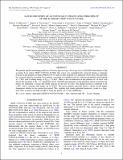NuSTAR DISCOVERY OF AN UNUSUALLY STEADY LONG-TERM SPIN-UP OF THE Be BINARY 2RXP J130159.6–635806
Author(s)
Krivonos, Roman A.; Tsygankov, Sergey S.; Lutovinov, Alexander A.; Tomsick, John A.; Chakrabarty, Deepto; Bachetti, Matteo; Boggs, Steven E.; Chernyakova, Masha; Christensen, Finn E.; Craig, William W.; Fürst, Felix; Hailey, Charles J.; Harrison, Fiona A.; Lansbury, George B.; Rahoui, Farid; Stern, Daniel; Zhang, William W.; ... Show more Show less
DownloadKrivonos-2015-NuSTAR DISCOVERY OF.pdf (731.6Kb)
PUBLISHER_POLICY
Publisher Policy
Article is made available in accordance with the publisher's policy and may be subject to US copyright law. Please refer to the publisher's site for terms of use.
Terms of use
Metadata
Show full item recordAbstract
We present spectral and timing analyses of Nuclear Spectroscopic Telescope Array (NuSTAR) observations of the accreting X-ray pulsar 2RXP J130159.6–635806. The source was serendipitously observed during a campaign focused on the gamma-ray binary PSR B1259–63 and was later targeted for a dedicated observation. The spectrum has a typical shape for accreting X-ray pulsars, consisting of a simple power law with an exponential cutoff starting at ~7 keV with a folding energy of E[subscript fold] ≃ 18 keV. There is also an indication of the presence of a 6.4 keV iron line in the spectrum at the ~3σ significance level. NuSTAR measurements of the pulsation period reveal that the pulsar has undergone a strong and steady spin-up for the last 20 years. The pulsed fraction is estimated to be ~80%, and is constant with energy up to 40 keV. The power density spectrum shows a break toward higher frequencies relative to the current spin period. This, together with steady persistent luminosity, points to a long-term mass accretion rate high enough to bring the pulsar out of spin equilibrium.
Date issued
2015-08Department
Massachusetts Institute of Technology. Department of Physics; MIT Kavli Institute for Astrophysics and Space ResearchJournal
The Astrophysical Journal
Publisher
IOP Publishing
Citation
Krivonos, Roman A., Sergey S. Tsygankov, Alexander A. Lutovinov, John A. Tomsick, Deepto Chakrabarty, Matteo Bachetti, Steven E. Boggs, et al. “NuSTAR DISCOVERY OF AN UNUSUALLY STEADY LONG-TERM SPIN-UP OF THE Be BINARY 2RXP J130159.6–635806.” The Astrophysical Journal 809, no. 2 (August 19, 2015): 140. © 2015 The American Astronomical Society
Version: Final published version
ISSN
1538-4357
0004-637X